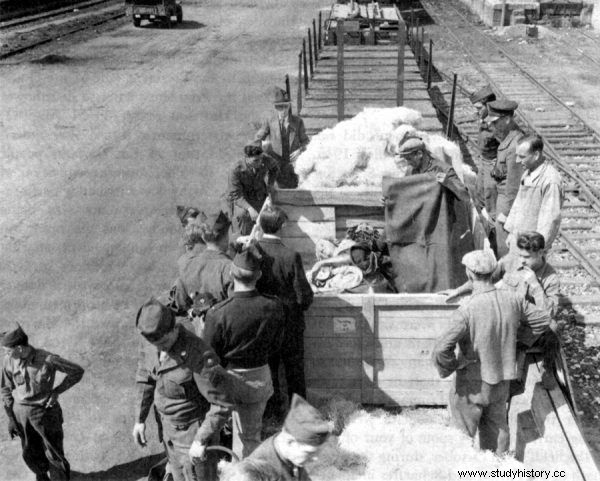Employee of the Department of Art History at the Jagiellonian University. An activist in the London government. A friend of General Władysław Sikorski. Above all, however, a man who contributed to Poland, even for several billion zlotys.
Karol Estreicher comes from a well-known and respected intellectual family in Krakow. His father, Stanisław, was a law professor at the Jagiellonian University. Grandfather, Karol, became famous for writing the Polish Bibliography. The youngest representative of the Estreicher family, however, is considered a black sheep in his home. Known for his sharp tongue, he uses life. In junior high school, he repeats a year. He likes the company of women. At the same time, he is truly obsessed with Polish culture.
In 1938, the Krakow Society of History and Monuments Enthusiasts began to operate. Estreicher, 32, is one of its most important members. Just before the outbreak of World War II, he proves how much he cares about his native heritage. Its goal is to save the priceless altar of Wit Stoss from German robbery.
As Marta Grzywacz writes in her book Obrońca Skarbów. Karol Estreicher - in search of looted works of art ":
For Estreicher himself, the only thing that matters is that the Marian altar was built in Krakow and for Krakow, therefore he, a flesh-and-blood Krakow native, must do everything so that the city does not lose his greatest work.
When he cannot convince the guardian of St. Mary's Church, Father Józef Kulinowski, to dismantle and hide the altar, he directs his steps to Archbishop Adam Sapieha.

Karol Estreicher made it a point of honor to save himself from the plunder of the altar by Veit Stoss.
The metropolitan of Krakow is committed to better understanding the political situation around him and allows the dismantling and preservation of Wit Stoss's work. The only condition is that the altar should be hidden in the buildings belonging to the church, which is why smaller elements go to crypts in Krakow churches and seminaries, and the largest figures packed in boxes are transported to the Sandomierz cathedral.
Let's save what we can
After fulfilling this mission, Karol Estreicher sets new ones for himself. He fights for rescue for the treasures of Wawel, Zygmunt August's tapestries, Gutenberg's Bible, Chopin's manuscripts and Szczerbiec. They left Wawel as early as September 1939, when the first bombs were dropped on Krakow. The most valuable paintings in Krakow are also hidden: Landscape with the Good Samaritan Rembrandt, Portrait of a Young Man by Raphael and Lady with an Ermine Leonard.
Wawel tapestries transported across the border to Romania and further to France and Great Britain will eventually wait out the war in Canada. However, the attempt to hide the paintings, which quickly find their way into the hands of Kajetan Mühlmann, delegated by Herman Göring to "protect" works of art in the occupied territories, turns out to be ineffective. The Germans also manage to obtain information about the place where the altar of Wit Stwosz was hidden. After being pressed, they are indicated by the Archbishop of Krakow, Prince Adam Sapieha himself.

Marta Grzywacz describes attempts to save Polish national treasures from the German occupier in her book "Obrońca treasów". (Polish Scientific Publishers PWN 2017).
Karol Estreicher was already in exile at that time. First he goes to France, and after its occupation by the Third Reich, he settles in London. He maintains contacts with the government-in-exile there, and tries to catalog works of art stolen by the Germans in Poland. And then he realizes the information he fears the most. The Germans reached the Sandomierz cathedral and plundered the St. Mary's altar. This news makes Estreicher feel guilty. As Marta Grzywacz notes from his journals:
" What am I guilty of? My God!" - this thought wakes him up at dawn and keeps him awake. "But I wanted the best - I made it bad that I undressed him. I will not rest for the rest of my life unless I see him back in place. ”
Recindication
Finding the altar now becomes a life mission for Charles Estreicher. Becomes the head of the Polish Cultural Property Restitution Bureau at the government in London. He is also active in the Commission for the Protection and Return of Cultural Goods, known as the Vaucher Commission. He is continuing his work on a catalog of cultural goods plundered in Poland with redoubled strength.

The interior of St. Mary's Church without the Wit Stwosz altar.
He believes that after the war it will be too late for such a catalog, which is why in 1944 he published Losses of Polish Culture, Catalog of Losses of Polish Culture under German Occupation 1939-1944 . At the time of creating this collection, he also finds information about the altar. This is how Marta Grzywacz describes this moment:
- There it is! I knew, I knew that they hid it there - it almost screams [K. Estreicher, n. ed.] , waving a small red-covered book in front of his amazed colleagues. This is a German guide to the General Government - Baedeker Das Generalgouvernement, published in Leipzig a few months ago. Professor Dagobert Frey writes in it that "The famous main altar, dismantled in parts by Poles at the beginning of the war, is now located in Nuremberg, the artist's hometown".
From that moment, Estreicher makes efforts to leave for Nuremberg, which he intensifies after the end of the war. Initially, it tries to get there on behalf of the London government. This one does not, however, support the idea of returning any hidden or stolen works of art to the communist authorities of Poland.

The confirmation of the speculation that the Germans had taken the altar to Nuremberg was great news for Estreicher. In the photo from 1937, the Polish Indiana Jones herself.
Estreicher recognizes, however, that Poland and Poles need their cultural heritage like never before. Marta Grzywacz writes: Why do they not understand that right now the identity of this nation is more threatened than ever, and if its culture is taken away, it will be annihilated.
Despite the opposition of the government-in-exile, it is trying to cooperate with the new government in Poland. As the former secretary of general Sikorski and an associate of the government in London, he did not gain the support of the communists. Ultimately, however, he receives a certificate signed by the deputy minister of culture and art, Leon Kruczkowski. This certificate makes him the official representative of the Polish government in matters of restitution of cultural property stolen by the Third Reich.
A few months later, he receives permission from the Americans to enter Nuremberg. Thanks to effective interrogations conducted by Lieutenant Walter Horn, it is possible to find out where the altar stolen from St. Mary's Church in Krakow was hidden.

The photo from April 1946 shows the moment of loading the altar by Wit Stoss, who is returning to Poland.
This place is a bunker under the castle hill. This is how Marta Grzywacz describes Estreicher's reaction after reaching the destination:
The high room is in order. The smaller figures lie on the shelves, the larger ones stand on the floor in neat rows, almost to attention, almost ready to report when called. The Estreicher looks at the gilded, undulating robes of the apostles and is tempted to say "rest," but emotion tightens his throat. They are, he found them. At last! After all those years! But are they all? He looks quickly over the faces of the wooden saints. Jan, Piotr, Szymon, Maria ... greet them in their mind as good friends.
Back
Finding the altar does not end the struggle for the return of the work to Krakow. First of all, the found elements were not complete, among other things, the altar cabinet was missing. After fulfilling the role of a treasure hunter, Estreicher is forced to assume the role of an investigative policeman. He personally interrogates Nazis who were captured and known to have participated in the plundering in Poland.

Marta Grzywacz describes attempts to save Polish national treasures from the German occupier in her book "Obrońca treasów". (Polish Scientific Publishers PWN 2017).
The key turns out to be the questioning of Dr. Wilhelm Schwemmer, who worked at the City Art Gallery in Nuremberg. Thanks to his testimony, the missing elements of the altar are found and Estreicher writes a letter to the archpriest of St. Mary's Church in Krakow, Ferdinand Machay:
I think in January, in the second half [1946 n. red], it will be possible to transport the altar. We do not know yet by what means, air or car. It depends on the Americans, who in this case go as far as possible. If the transport will be by road, then the American fire will come with him.
However, the goal is not achieved until six months later. On April 28, 1946, a train departs from Nuremberg carrying the greatest treasure of Polish sacred art. From the very border, he is greeted by crowds of Poles. The human mass also fills the platform of the Krakow railway station. The altar returned to Krakow. But would he have left it at all if it hadn't been dismantled before the war?
Buy from the publisher's site:

